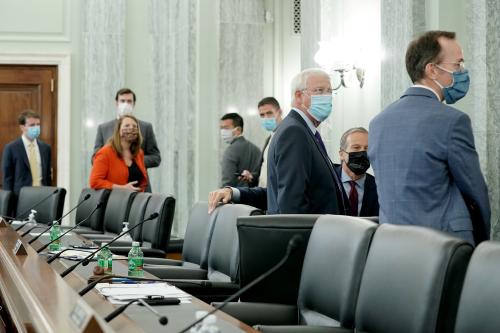The White House and the Office of Management and Budget (OMB) recently issued major and long-awaited changes to the processes for formulating, analyzing, and reviewing agency rules, delivering on a promise made on the first day of the Biden administration. This piece highlights and analyzes important aspects of these documents. If successfully implemented, these reforms would push OMB and agencies to incorporate technological advances into the rulemaking process, increase engagement with traditionally underrepresented parties, provide OMB greater discretion over its rulemaking review, and allow agencies to analyze a wider range of benefits and costs, likely justifying additional regulation.
Unlike dramatic changes implemented by the prior administration, however, the Biden reforms are incremental reforms to the existing and longstanding regulatory framework. They therefore stand a better chance of enduring. However, they could still be repealed by a subsequent administration through an executive order and new OMB circular issued without public notice and comment and with little threat of litigation. While they are consistent with a more progressive view of regulation, the changes do not abandon cost-benefit analysis. Rather, they are grounded in recent developments in the academic literature and appear designed to help agencies produce cost-benefit analyses that will withstand judicial scrutiny.
This piece focuses first on the Executive Order (“Order”) modifying OMB regulatory review process and then unpacks proposed updates to the main guidance document governing how executive branch agencies conduct cost-benefit analyses.
Executive Order on Modernizing Regulatory Review:
The Order makes incremental but important changes to the OMB regulatory review process. Implementation of these changes, detailed below, will largely fall to the office within OMB that reviews rules, the Office of Information and Regulatory Affairs (OIRA). Three themes connect the changes. First, the Order pushes OIRA and agencies to ensure the rulemaking process reflects technological advances. Second, agencies and OIRA are encouraged to increase engagement of traditionally underrepresented parties in the rulemaking process. Third, OIRA is given greater discretion over its workload. This is an important change, because OIRA has seen its workload (which includes other responsibilities such as reviewing information collection requests under the Paperwork Reduction Act and determining major rule status under the Congressional Review Act) increase over time while its staff level has actually fallen from approximately 90 staff members in the early 1980s to 45 staff members today. Better utilizing these limited staff resources could help OIRA increase its influence.
Increased Threshold for Rules Reviewed as Economically Significant
The Order raises the threshold for rules reviewed as economically significant increases from an annual economic impact of $100 million to $200 million and creates a process to periodically increase the threshold to account for inflation. This long overdue change updates a threshold first set in 1981—adjusting for inflation, the 1981 threshold would be approximately $332 million today. Absent the change, inaction in the face of inflation would continue to expand the set of rules that require OIRA review. This change will help OIRA staff focus their limited resources on rules with a higher impact. As detailed below, OIRA retains the discretion to review rules that previously would have been reviewed absent the changes.
Require OIRA Head to Approve Discretionary Review of Rules
The Order requires approval by the head of OIRA (or a senior official designated by the OIRA head) before a rule may be reviewed discretionarily. Previously OIRA staff could initiate discretionary review without the Administrator’s consent. Depending on the preferences of the OIRA head relative to the OIRA staff, this change could reduce the level of discretionary OIRA review. It may also shift authority away from senior OIRA staff toward the OIRA head. If the result is less discretionary OIRA review in at least some administrations, then agencies would receive somewhat less stringent oversight. On the other hand, if the result is better-targeted OIRA review, then reviews might be more exacting even if fewer in number.
Increased Engagement of Under-Represented Communities in Rulemaking
Agencies are directed to be more proactive in engaging underserved groups (defined in OMB guidance as including persons of color, religious minorities, women and girls, LGBTQI+ persons, persons with disabilities, persons who live in rural areas or U.S. Territories, and persons adversely affected by persistent poverty or inequality) in the rulemaking agenda-setting process and in the rulemaking process itself. As part of this work, agencies are instructed to clarify and publicize the process for how the public can file petitions to request initiation of rulemaking. Agencies are also directed to maintain a log of such petitions. Relatedly, the Order tasks agencies with conducting additional outreach to underserved groups during the rulemaking process, including through community organizations, agency field offices, and alternative media. The impact of these provisions will depend heavily on the extent of implementation by OIRA and agencies.
Enhanced OIRA Transparency
The Order directs OIRA to revamp its process for meeting and interacting with the public during the rulemaking process. This provision is intended to increase transparency and to counter criticism that the OIRA review process favors well-organized interests at the expense of individuals and groups in underserved communities. The guidance also seeks to increase OIRA efficiency by consolidating meetings with groups that have similar views and discouraging duplicative meetings. OIRA published for public comment guidance on this issue, asking if it should determine whether meeting requestors are registered lobbyists and whether more meeting materials should be made public.
Technological Updates to the Rulemaking Process
The Order also instructs OIRA and agencies to work on reforms that may include guidance or tools to address mass comments, computer-generated comments (such as those generated through artificial intelligence), and falsely attributed comments. This is an especially timely subject given the recent proliferation of ChatGPT and other generative AI, but this part of the Order is mostly a placeholder for action to be taken later. The impact of this provision will depend entirely on implementation by OIRA and agencies.
Important Changes to How Agencies Conduct Cost-Benefit Analysis
Finally, the Order requires agencies to recognize distributive impacts and equity to the extent allowed by law. OIRA took a significant step toward implementing this provision when it proposed for public comment detailed revisions to its guidance for agencies on conducting cost-benefit analysis, which is detailed in the following discussion.
Proposed Changes to Cost-Benefit Analysis Methodology
OMB Circular A-4 provides agencies with OMB’s guidance for conducting cost-benefit analysis (also known as benefit-cost or economic analysis). While technical, the proposed revisions would push agencies toward analyzing a wider range of benefits and costs. Agencies would also be directed to consider non-economic rationales for rulemaking and to give greater weight to benefits occurring overseas and far in the future. Taken together, these changes would likely increase estimations of benefits without changing costs, thereby helping agencies justify additional regulation.
Updates Reflecting Research Progress
At the outset, it should be noted that the proposed revisions provide many updates to reflect progress in economic and related research since Circular A-4 was first issued in 2003. For instance, the new guidance discusses how human decisionmaking biases and information processing limits may justify regulation, a topic that was much less developed in 2003. The new guidance also contains a greatly expanded discussion of how agencies may analyze a specific market in isolation from the remainder of the economy (termed “partial equilibrium” analysis). Many of these changes should be uncontroversial.
Expanded Rationales for Rulemaking
The proposed revisions also expand the set of rationales for rulemaking, which have generally focused on market failures such as externalities or imperfect information, to include: 1) promoting distributional fairness and advancing equity, and 2) protecting civil rights and civil liberties or advancing democratic values. These additional rationales contemplate rulemaking with benefits that may not be easily quantifiable, addressing criticism that cost-benefit analysis systematically neglects such policy initiatives. For instance, cost-benefit analysis has long been criticized for failing to include the benefit of increased dignity to those protected by rules issued under the Americans with Disabilities Act. The expanded rationales in the updated Circular A-4 would give agencies greater latitude to use such benefits as the rationale for such rules provided this is consistent with their statutory authority.
Consideration of Qualitative Benefits and Costs
Relatedly and importantly, the proposed revisions include additional language on the practical difficulty in many cases of quantifying and monetizing benefits and costs. The new language more strongly encourages agencies to consider such benefits and costs. It also emphasizes that the alternative with the greatest net quantifiable benefits may not produce the greatest improvement in social welfare considering nonquantifiable benefits and costs. This is consistent with the 2003 version of Circular A-4, which stated that the “most efficient alternative will not necessarily be the one with the largest quantified and monetized net-benefit estimate.” Like the prior version, agencies are encouraged to provide the economic basis for unquantified benefits and costs and explain how they fit within the broader analysis. The revisions also more fully encourage agencies to assess uncertain benefits and costs, outlining assumptions used to address such uncertainty.
Analysis of Impacts on Subgroups
The proposed Circular A-4 also encourages agencies to consider the effects of their rules on specific subgroups (termed “distributional analysis”) rather than simply selecting the rule with the greatest net benefit. This change is rooted partly in concern that cost-benefit analysis methodology can privilege those with greater ability to pay by valuing their preferences more highly. It is also rooted in a broader concern that the rulemaking process should be more accessible and responsive to traditionally underrepresented parties. OMB notes that appropriateness of distributional analysis varies both by the policy under consideration and the legal framework. Distributional analysis may be done by income, geography, race, gender, age, or other variables depending on the circumstances. Doing distributional analysis in practice is difficult given data limitations, and it will be interesting to see if commenters provide additional suggestions.
Method of Valuing Impacts on Future Generations
Policy choices made in the rulemaking process often have benefits and costs long into the future. These future benefits and costs must therefore be converted into present-day dollars, a technique known as “discounting” to the “present value.” The proposed Circular A-4 reduces the default discount rate from 3% and 7% (agencies generally analyze costs and benefits using both rates) to 1.7% (agencies could also present analyses with other discount rates to show the sensitivity of their results to the choice of a discount rate). The net effect would be to increase the present value of rules with significant benefits in the future as those benefits would be discounted much less. This would generally increase the net benefit calculation for rules, which typically involve high up-front compliance costs and benefits years in the future. Climate change rules are the most prominent (and perhaps the most tangible) example of how reducing the discount rate places greater value on future impacts relative to the present.
Scope of Benefits and Costs Considered
The proposed revisions would give agencies greater latitude to consider the global effects of regulation. Put in cost-benefit parlance, the benefits and costs of rules to people outside the United States could be given “standing.” This too is particularly important in the environmental context given that many environmental issues have effects outside our national borders, with climate change again the most prominent example. Indeed, in analyzing the Clean Power Plant Rule, the Obama administration used global standing, and the Trump administration restricted the analysis to the United States. The net effect of the change was to reduce the benefits of the rule while the costs remained relatively constant. Under the new guidance, agencies would be instructed to return to the Obama approach.
Conclusions
The rulemaking process reforms highlighted in this piece would be meaningful if well implemented. Agencies and OIRA would engage more with traditionally underrepresented parties when formulating rules, OIRA would have greater discretion over its rulemaking review, and agencies would be expected to analyze a wider range of benefits and costs, likely producing greater net benefits of regulation at the margin. The rulemaking process would also be updated to make better use of recent technological developments.
These changes undoubtedly reflect a more progressive view of regulation. Yet, they do not jettison cost-benefit analysis. Instead, they have a basis in recent academic research, and they appear to be designed with an eye toward helping agencies withstand court challenges to their cost-benefit analysis. Many of these reforms would therefore have a reasonable chance of lasting through future administrations as improvements on the longstanding regulatory analysis and review framework.
Connor Raso is a senior associate general counsel at the Public Company Accounting Oversight Board. The views expressed here reflect only those of the author.
The author did not receive any financial support from any firm or person for this article or from any firm or person with a financial or political interest in this article. He is currently not an officer, director, or board member of any organization with an interest in this article.




